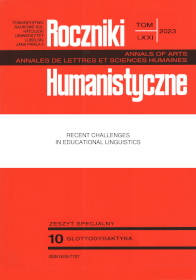The Use of Gender-Marked and Gender-Neutral Forms: The Importance of Linguistic Corpora in Increasing the Linguistic Awareness of L2 Learners of English
The Use of Gender-Marked and Gender-Neutral Forms: The Importance of Linguistic Corpora in Increasing the Linguistic Awareness of L2 Learners of English
Author(s): Bożena CetnarowskaSubject(s): Language and Literature Studies, Applied Linguistics, Language acquisition
Published by: Towarzystwo Naukowe KUL & Katolicki Uniwersytet Lubelski Jana Pawła II
Keywords: occupational terms; corpus; English; gender-marking; gender-neutral forms
Summary/Abstract: This paper discusses some corpus-based activities which can be used to increase the sensitivity of advanced L2 learners of English to the constraints on the occurrence of gender-marked forms in English. Guidelines for gender-inclusive language recommend replacing gender-specific job titles, such as fireman/firewoman, with gender-neutral nouns, i.e. firefighter. By investigating examples gleaned from the Corpus of Contemporary American English and the British National Corpus, learners of English can identify the conditions under which gender-specific forms may be employed. They can also see which type of gender-marked forms occurs more commonly in each of those corpora (e.g., woman driver or female driver). A further online corpus known as Global Web-Based English can be used with advanced L2 learners of English as a source of data indicating different attitudes towards gender-marked forms in native and non-native varieties of English, as can be shown for occupational terms with the modifier lady.
Journal: Roczniki Humanistyczne
- Issue Year: 71/2023
- Issue No: 10S
- Page Range: 61-77
- Page Count: 17
- Language: English

